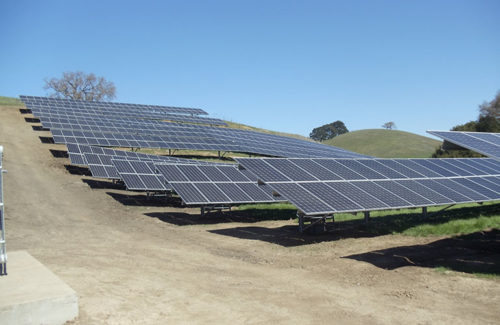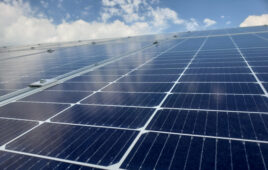Ground-mount solar arrays are typically installed in mostly flat open fields, especially on utility-scale projects. Certain solar markets, like Florida, have naturally level land, which makes installs simpler, but flat terrain isn’t always an option. Solar sites in the Northeast, mountain states or hilly regions can undergo civil engineering to make level ground for mounting. Yet, grading land can alter rain runoff patterns on the site, possibly displacing native species and raising project costs.
“You’re never going to have a perfectly flat site, anyway. No matter where you’re at there’s going to be some sort of undulation,” said Rob Stoll, photovoltaic tracker design manager at RBI Solar.

A ground-mounted solar array ascends up a hill. While it’s simpler to install solar on flatter terrain, hills and undulating ground are feasible solar sites. RBI Solar
The workaround to undulating topography is non-intrusive mounting options made for slopes, grades and hills. The common solution is extended post length, but installers can make custom brackets or install panels in smaller rows or single-bay tables.
GameChange Solar has a history of working in the hilly terrain of the Northeastern United States. The company has spent the last several years manufacturing solutions for mounting on undulating project sites and helping installers avoid civil engineering.
“We’re looking at some significantly large projects in the mid-Atlantic that the panels are running around ravines or little streams and their topography changes accordingly,” said Scott Van Pelt, senior director of engineering at GameChange Solar. “Unfortunately, it’s going to continue to get harder, and the onus is on the civil companies and the rack manufacturers to continue to advance what they can do on a desktop level, and also work with the fields to make sure all the [surveying] information is accurate, and provide more tolerance to installers in the field to accommodate that.”
GameChange Solar’s MaxSpan mounting and racking solution, which has an added 6 to 9 in. of post length, is ideal for undulating terrain types. The purlins connecting the racks can adjust to up to 15% inclines. The extra post length allows installers to place racked modules in succession on hilly terrain.
“Every time we’ve worked with a developer or installer to do cost-benefit analysis, if you can solve the problem with more steel and more post length, as opposed to grading, it is always more cost-effective to use more steel. I do know there are installers who prefer to do civil work,” Van Pelt said. “It’s their preference, but it doesn’t necessarily mean it’s the best or most cost-effective solution.”
Installation delays mean solar companies are losing money. Ground-mount installers require accurate CAD topography renderings of array sites to ensure an efficient work schedule. This is more pertinent on hilly array sites, especially when trackers are added to the mix.
“If we can eliminate any additional site work or civil work that needs to be done, then it’s even more beneficial for cost savings, and our system is built inherently with adjustability,” said Mike Freshwater, ground-mount design manager and landfill manager at turnkey mounting specialist RBI Solar.
RBI Solar makes racks and mounts specific to each project in-house—whether it’s a flat site or hilly. If a proposed solar project will use trackers, RBI conducts analyses from topography files to determine if the site has topography with grades beyond a tracker’s operating threshold.
“If we can accommodate in our racking system ways to design around that so we don’t have to not build a system or make drastic modifications, it saves the customer a lot of money so that the project will better pencil for them,” Stoll said.
Team members at RBI said civil engineering is a project budget killer, and hilly sites tend to be cheaper than naturally flat or graded ones.
Cliff Schrock, a technical consultant with solar ground-mount company SunModo, has had a hand in installing 300 solar arrays since 2002. He said there are advantages to mounting on hillsides, “particularly if it’s sloped south-facing. It can be more cost-effective, because you’re cutting out some of the materials too, for the post links, and you can go denser because of the integrating.”
Posts are still built out of the hill vertically. Panels installed on rolling hills follow the contours of the land, but technically remain flat relative to the ground. Schrock has witnessed installers working on 20 and 30° slopes, but with much difficulty.

SunModo installed a residential ground-mount solar array into a hillside. SunModo.
When SunModo works a hilly site, the company uses its SunBeam system, a ground-mounted rack, installing clusters of four-by-four landscape panels. Each four-by-four array is fitted differently to the ground than the others, but all are placed in close proximity. Arrays can be installed on slight, steady grades with posts deeper into the ground following the contour of the land. In some cases, due to the incline, the posts will appear the same length.
The company is currently exploring other racking solutions for undulating terrain.
“It’s all about land-use,” Schrock said. “If you have a perfectly flat field you can do a lot of things with it. If you’re in a hilly terrain, there may be nothing else you can do with that land other than graze cattle or sheep on it. Why not build it up with solar?”





Hi Billy, I am doing my master thesis on solar energy engineering. My project is to install a centralized PV plant on an uneven terrain in central Sweden (several orientations and slopes). Do you have any article, guideline, thumb-rule or any suggestion on where to look about recommended slopes for ground mounted PV systems?
We are building a solar power plant in southern Portugal with slopes over 20 degs and have installed the panels on east, west and north slopes as well a the south facing slopes. Added to that we have to contend with rock throughout site , poor access and flash flooding. It has been a lot of fun to build! https://goo.gl/maps/YLmnm64JFQ2a5FqQ7
Contact me if you want some advice.
Hi Breandan,
I saw your project, very interesting. Do you performed a cost effective analysis a cost-benefit analysis to know which solution is cheaper, using more steel (more post length) or leveling the site (cut and fill). I realized that in your project you decided to follow the topography.
Hi, may i know know what is the solar capacity in MWac?the area is 320Ha?
Hello Breandan, sounds like you’ve been having to work on some challenges! We are putting together a system here in the eastern USA which is multi-megawatt in scale, for a slope which is >= 30°. Our current idea is to use anchored concrete ballasts to aid with erosion control once the trees are removed, and to use those same ballasts to create a single, hill-spanning “mat” of racking on which to mount our modules.
I’d love to discuss some ideas with you. If you see this, please feel free to reach out. Our website should be linked to my username here, and you can contact me from there (I’d like to avoid putting my contact info here to keep it safe from phishers and bots).
What about rain water run off from solar panels mounted on sloped roof reaching neighbor’s property creating drainage problems? This has to be a liability issue.
George Gowland
Thanks for the kind reply.
Would you happen to have electronic copy of the guideline on the slope requirements either in Japan or in the U.S. that you can share? I am looking to build solar farm in a region not favorable for anything but solar because of the topographical condition.
Other than civil engineering challenges to install solar panels over uneven and steep hillside lands are there land use regulation that limits the steepness of the land on which solar panels are permitted?
I have designed (and supervised installation of) 300MW in Japan. Not a single acre of my projects was on flat land.
We moved millions of cubic meters of dirt for these projects, to get the slopes down to 15-25 degree slopes, here in Japan. Now we’re looking at >25 (even > 30) degree slopes.
Ideas welcome.
Hi Martin,
Have you performed a cost effective analysis to know which solution is cheaper, using more steel (more post length) or leveling the site (cut and fill).
Best,
Dr. Shoghi
We’re in the process of designing a system on a >30° slope here in the eastern USA. It’s very rocky, so that drilling holes is not an option. We are working with various ideas for erosion control systems made from anchored concrete ballasts to also hold the posts on which our arrays would be mounted.
You’ve been working on steeper slopes recently, do you have any pointers?
Same here. Eastern TN, three choices: up, down, and sideways. Nothing is straight or level with lots of >30° slopes that are curving, little chance of drilling, and no chance of anything but (mostly empty) 4WD trucks. The portable panel people make some interesting stuff; however, they don’t do anything that has 4 adjustable supported corners. One could probably find non-specific jacks, but that doesn’t solve the problem of concrete piers into rock.